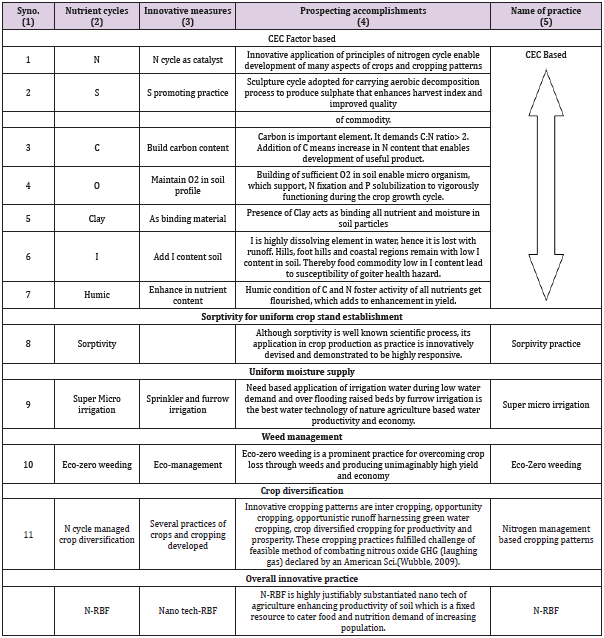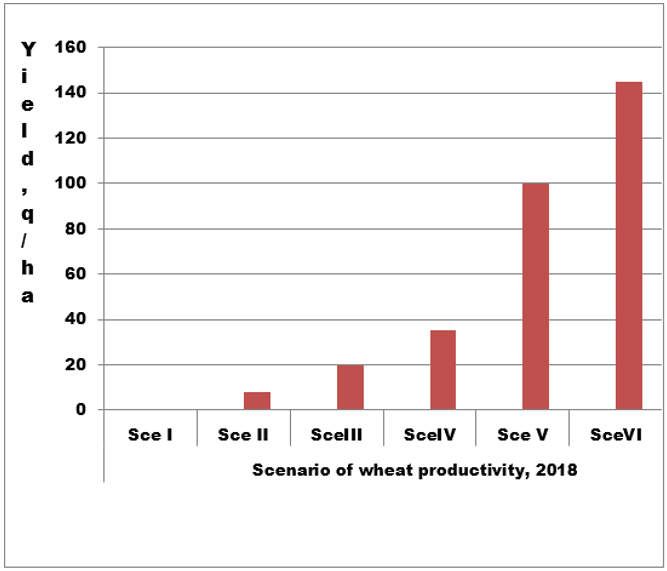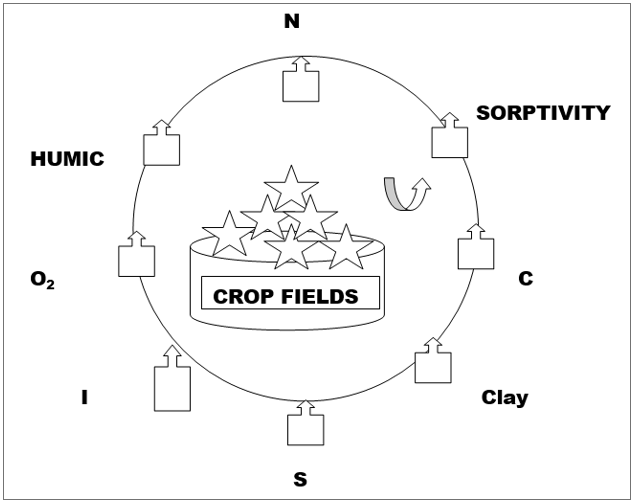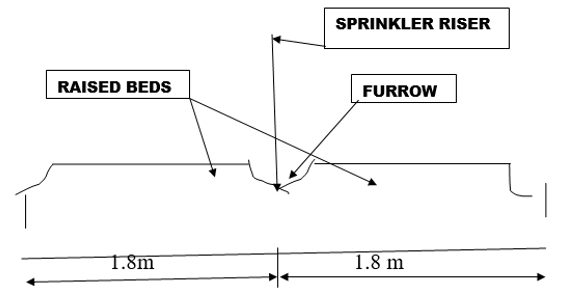Nanotech in Agriculture for Eliminating Global Hunger and Inadequacy of Nutrition Accomplishing United Nation’s Sustainable Development Goal
Introduction
Food and nutrition is always increasing concern for growing population, which causes worry to food policy thinkers and planners. There had always been look for finding potential powerful technology to be able to shoulder the burden and overcome the worries. Top surface of the Earth consisting soils, which support plant material producing primary food chain producer for fauna and all species including human. The productive capacity of the soil depends on how it transforms plant nutrients in form that it is readily absorbed by root and transmitted to other part of the plant. The soils become habitat Eherler, et al. [1] for plant and water nutrient supplementations contain cation exchange capacity (CEC) (Guftafson, et al. [2-4]). The seven cations viz. N, S, O, C, Cl, I, Humic and other 15 Anions combine to form plant nutrients readily absorbed by root hairs and promote growth and yields of crops. There had been some ways to supplement the plant nutrient with different types of fertilizers, based on randomly applied and good experience gained on increasing means of crop yield in agriculture Guftafson. There had been need to completely understand process so that a good practice for management of the essential nutrients (Appendix Table 1 and Appendix Figure 1) and allied compound sufficiently get but in regular process, which becomes ideal agriculture practice. Objective of the present study was to review the cation exchange process and form basis for enhancing by innovative supplementations of the factors. The resulting practice will become an ideal set to compare past practices in vogue.
Materials and Method
Soil CEC
Soil has existed around 4500 years ago and people understood many aspects by doing and learning of raised beds and furrows (RBF) (Fisher, et al. [5-14]). The practice of RBF got transformed in to permanent raised bed and furrow (PRBF) and there to same situation of doing and learning (Beechar, et al. [15-18]) mostly previous ones in Australia, Knowledge of action exchange capacities of soil particles and plant nutrients were also known for long time back. The details of CEC and how it comes in effect to enhance plant nutrients are sufficiently clear from details available in text books (Appendix Table 1 and Appendix Figure 1). In Table 1 column (1) - (3) contain the CEC factors and innovative development aspects in the present study. In the study elemental ionic combination formed, hence developed practices become Niño Tech practices of CEC. Since agriculture also involves many supporting aspects, which support lateral and vertical growth are also included beyond the CEC factors in Table 1. Although some practices in one or other forms were adopted, implication of CEC as nana technology is new insight on enhancing productivity of soil. The resulting N-RBF practice proved as the most suitable and highly adoptable by farmers and agriculture practiceners. Many other innovations associating with the N-RBF were also brought for supplementing it, which enhanced efficacy of its productive functioning.
Experimental Study on Evaluation of CEC Factors
Field experimental study data on experimental field study were derived in 2017 on the field condition which get reflected by prevailing CEC factors and forming various scenarios in cultivation of wheat following harvest of paddy in October 2017, on farmer’s field in technology ignorant village at Dhobahan, Distict Allahabad, Uttar Pradesh, India. Since CEC factors cannot be created in most of the cases, different site conditions represented vide field Scenarios ware adopted. Measures such as N, P, Sorptivity and irrigation etc were adopted, which will be presented in result part of the study. Many innovative developments, which support the CEC of N, S were taken from various innovative studies (Yadav, et al. [19-32]) depicting various prominent features (Table 1).
Results
The CEC Factors
Figure 1: Yield harvets under different field crop situations in 2018 at the experimental site under the study. ( Note Sce Ino cropping; Sce II poorly maintained cultivated;Sce III moderately maintaind cultivation; Sce IV normal yield produced by farmears in adjoinig area.;Sce V- yield from experiment and Sce VI still higher potential yield with innovative practice adoptions).
The CEC based nano tech practices and some associating practices constituted the Nano RBF practice as new substantiating CEC Nano Technology in column (4) and Column (5), constituting almost 11 practices. There had been tremendous advancements on N managed copping which are new innovations. Likewise study had established not adequate use of S, as usual practice. The application of sculpture cycle A full-fledged research study was accomplished on sulphur cycle based practice as an aerobic decomposition of agricultural tissues, producing high crop harvest index, known as NADEP composting in some part of India. The sulphur cycle is depicted in Figure 1 as environmental chemistry based innovation. There is hunt to find a suitable measure to reduce time required completing cycle of composting. The Usual time for Composting is 16 weeks. Thus, shortening of composting time will foster natural long process. Such innovation will help the nano tech of RBF flourish vigorously. The innovation on building one element and its support on C is well known. Cow dung is ancient past practice for building c content of soil.
Plentiful researches were conducted on building on soil organic carbon. Innovative measure of recycling resides in to biochar and adding in soil is also prominent opportunity. Thus, it is becoming clear that practice which comes in use provide opportunity to understand process that will lead to new innovation in fostering the cause of the practice. Thus, it was a natural phenomenon, revealing that when something is innovated, several refinements will keep coming on improving efficiency of new innovations. The CEC I is manageable to uplift low levels due to erosion in some specified areas. Tankage of fishery and fish manure enhance its nutrient level which supplement I. Other aspects of the building CEC Clay and humic are dealt with in some other studies.
Cycle of Revolving of CEC
The CEC factors are fixed at important cores and should revolve in irrotational movement as depicted vide Figure 2. The irrotational type of revolving cycle enables keep the desirable function in under all situation (Ramamrutham [33]), without producing any adverse result. The season is fixed hence its beginning should follow the sequence. It is pertinent to note that season might vary from Northern hemisphere to Southern Hemisphere, which might require different type of cycles. of revolving, but the irrotational cycle of rotation make the nano tech of N- RBF being applicable under all such varying situation. Therefore, the nano tech of N-RBF is universally applicable. The emphasis on plant nutrient will accordingly follow need of crops. The CEC core factors are N, S, C and O2. Clay is also important factor that binds group of compounds. Iodine (I), a new visualization for enhancing quality of food commodity produced. Besides the CEC factors, another important factor is sorptivity, which is an innovative factor, included with implication that bringing uniform and fast stand establishment is highly important for vertical and lateral growth for summed yield per ha.
Enhancements of Crop Yields Under Different Field Scenarios
There existed various field scenarios surrounding experimental study site in the present study on various CEC factors and associating innovations listed in Table 1. Figure 1 was developed with yields of wheat crops in I- VI scenarios. Sci I saline and water logged, which did not sown due to late walk able condition, making all CEC factors get suppressed by the excessively water logging condition. Sce II till Sce IV were with little and low care for enhancing CEC factors, as disheartened farmers with low yield. There appeared some improvement in yield as a result of application of N through urea, with lack of other CEC boosting factors. Sce V was the experimental results with innovations listed in Table 1, which produced wheat yield by almost three fold of yield harvested by progressive farmers, in general. The Sce VI is the situation with good buildup of Sulphur fostered CEC, which had lac in agriculture world over (Yadav [34]). The enhancement in wheat to new plateau is contributed by S bringing high harvest index with other measures of Sce V. Although this increase will make agri scientists get perplexed. It is further brought out here that the N cycle management cropping practice is capable to bring equivalent wheat yield up to 172 q/ha. Thus, this innovative technology is capable of producing huge quantity of food commodity that will bring sustainable food sufficiency and nutritional adequacy.
Final Form of the N-RBF
Innovations listed in Table 1 and Figure 1 about their relative sequencing and revolving in irrotaional fashion were dealt with. The scenario wise progressing inhancement in yield in Figure also were established. Therefore, study moved to substantiate module of N RBF, as most innovative technology of RBF fulfilling different CEC aspects that make it the most innovative technology of afloat land brought after any kind of known reclamation measure. The stepwise innovations on CEC converting in the N-RBF are as follows. The N RBF creates 92 % of land transformed to raised bed provide and enable all N based innovations acceptable and fostering productivity. The raised beds enable sufficient aerobic condition, hence supply of O2 is naturally enhanced and maintained, when it is formed every time before seeding/planting. The organic carbon in built by adding one fourth of recommended dose of N, P and K, usually as practiced in the country. Government claim tall success on soil health cards. Researches had established that one fourth of N should be through organic sources for getting enhanced productivity.
This organic supplement through compost and aerobically decomposed (NADEP) at least 20 days before sowing and incorporated for eliminating any damage of seedlings due to heat release by to manures. The well plowed land and formed in RBF also accepts N based practices hence this enable enhance, ratio always > 2 and S also enhanced to bring high high harvest index. Superiority of NADEP was well established in study The Clay CEC is sufficiently existing, hence this factor needs extra building in sandy desertification soils. This enhancement in Clay had been as an innovative measure for combining the Clay building innovative practice of pellet forming (through drop formation) and sowing with other manures in seed rows, in lieu of spreading on entire land areas, which might not appear feasible. Iodine (I) supplementation will get enhanced by applying irrigation water enriched with nutrient from fish tanks. The sprinkler irrigation will enable uniform spread of small quantity of water on entire field surface. The super micro irrigation is well established saving in irrigation water established by earlier studies in past seven decades.
The every time freshly formed raised beds will have low compacting effect and at the same time eco zero weeding will eliminate any need of weeding and secondary tillage. The row crops cultivated with ridge and furrow ill accommodate additional no of rwos that will enhance yield by a factor of 2.66, benefitting potato and spice crops viz ginger and turmeric etc. Thus, it brought additional advantages by building N-RBf, which is depicted vide Figure 3. This land form is formable by general purpose tractor, enable farmers adopt for enhancing productivity of agriculture.
Discussion
The present study developed nano technology based RBF which uses cation exchange capacity elemental process and culminating in N-RBF. This new practice is scientific advancement of enhancing soil productivity after land with any kind of limiting problem is reclaimed to bring in arable flat land form. The productivity of such precious and limited resource had been declining causing worry of food situations for increasing large population. There were some innovations viz raised bed and furrow and laser leveling, but none of them become complete supplemented of CEC, highly involved in enhancing productivity of soil. Earlier researches on the RBF, were not such sound scientific footing which is the ECE in new aspect and brought several innovation to make the N-RBf as highly fixed in desighn, easily formable, providing support of plant nutrients, adequately equipped with supporting innovations of sorptivity, super micro irrigation, eco- zero weeding that make tasks of agriculture least susceptible to drudgery, Highly free from any risk of failure due to change of climate. The practice reduces carbon foot print and fulfills challenge of simple method of reducing nitrous oxide, the laughing gas, which has been known cause of making ozone hole in arctic. This NRBF is the best practice in its domain, not likely to get surpassed by any one in future. These results are ratified under different sub heads. in the following part of discussion.
Nano Technology
The CEC is elemental characteristics and involves elemental process, which is nano process. Any practice which fosters the nano proves automatically becomes nato fostering practice. As brought out in Table 1 all nano processes were brought in form and practice. Finally when all nano functions are performed by nano process the final composite practice also becomes nano technology. Therefore, N-RBF is sufficiently justified to act as a nano tecch- RBF.
Innovative Development
The raised bed and furrow originated to overcome problem of compaction during intensive movement of agricultural machineries in U.S.A and Australia, taking form of fixed row agriculture. It produced increased yield and brought saving in irrigation water and also crop diversification in agriculture. Many developed countries launched special project on the RBF in South East Asian countries viz Bangladesh, India, Indonesia, Nepal, Pakistan and Philippines. China also started the RBF by seeing the advantages of the RBF. The RBF highly popular in Western Australia is adopted for sugarcane, and cotton. In India and Pakistan it became popular for maize and wheat in northern plain Indo Gangetic zone (Maurya Singh, et al. [35-38]). The RBF practices had some limitations due to which it could not get popularly adopted by farmers. In the most of countries it left ground due to non availability of low cost and low energy input machinery for bed formation. The basic scientific facts prevalent during those times could not bring the useful RBF in adoptable practice.
Mostly researches remained searching benefits; hence some scattered and scanty researches kept coming and going, making the RBF insignificant for popular and intensive technology for plausible adoption. In India the RBF could not be adopted even for long duration crops such as sugarcane and cotton. The visible craze for adoption of new agriculture practices appeared for new corps, seeds and irrigation by installing pumping setups. Largely, land and water management practices remained with research organizations.
N-RBF Format
The final format was improved for its size for formation eliminating problem of any special machinery and overcoming problem of traffic compaction as in past, eliminating problem of raised bed soil getting compacted, getting free of any problem of weeds due to support of innovative practice of zero weeding, support of sorptivity and manures to take care of C:N ratio and S CEC buildup. The support of super micro irrigation made it free of water scarcity and surplus wetness under the changing climate. Thus N-RBF served as auto drainage and sustainable moisture and nutrient supplementing the crop cultivations. The present form of N- RBF (Figure 3) will stay long fostering soil productivity. As this is the most advanced technology taking care of soil productivity, it will take some time to let people realize benefits and leave laser leveling, which got popularized in the name of laser, an advance science becoming ground for convincing users by seeing spread and flow of irrigation water, bringing saving in irrigation water and water use efficiency (Jat, et al. [39,40]). When unimaginable yield and other benefits come to realization, which get buildup due to involvement of natures, it will overtake the use of the laser leveling. (Adak Tarun, et al [41-46]).
SWOT Analysis
The N-RBF is with strong scientific strength, it is free of any weakness, creating lot of opportunities in agricultures and there is no any threat. It is new science based earlier known, but not adopted by people. The practice will now come in adoption by people. (It is advancement in domain of enhancing productivity of soil by CEC, basic characteristic involvement of enhanced scientific fact brought in usable practice (Jat ML, et al. [47-55]).
Conclusion
The CEC fostering Nano Tech RBF is free of any limitations experienced in past and pulled by engine of innovative technologies that enhance its efficiency, convenience of adoption and bringing sustainable development goals. This innovative RBBF is superior to the most other known practice of enhancing yield of crop as a function of soil productivity. It forms complete scientific innovative development on soil science and plant nutrition. Thus, N-RBBF is an intellectual property available for world agriculture to use and prosper.
For more Articles on: https://biomedres01.blogspot.com/






No comments:
Post a Comment
Note: Only a member of this blog may post a comment.